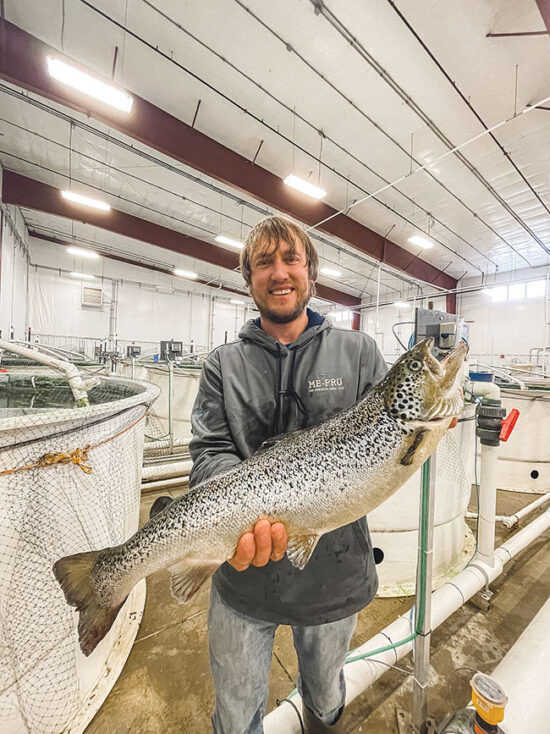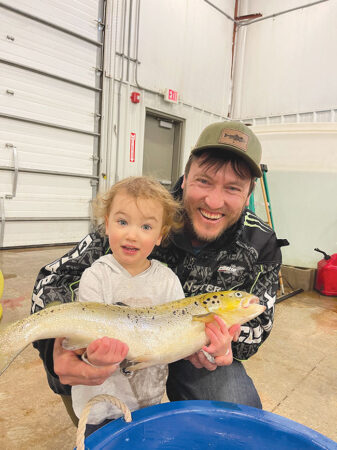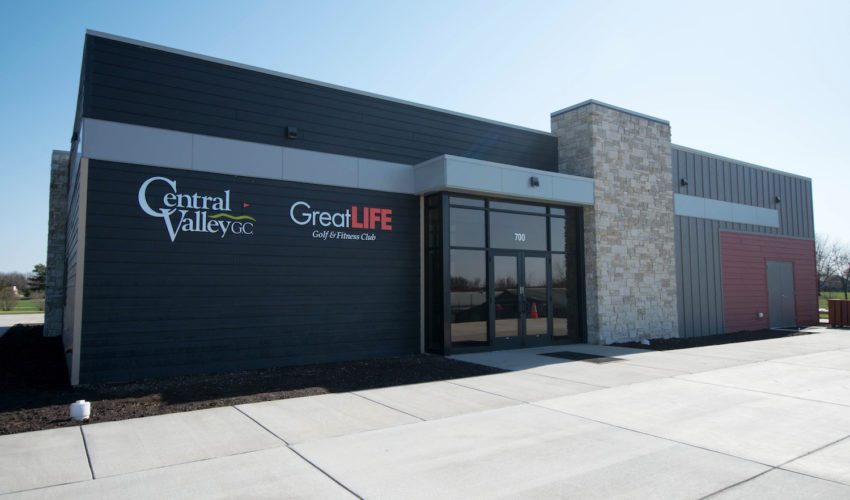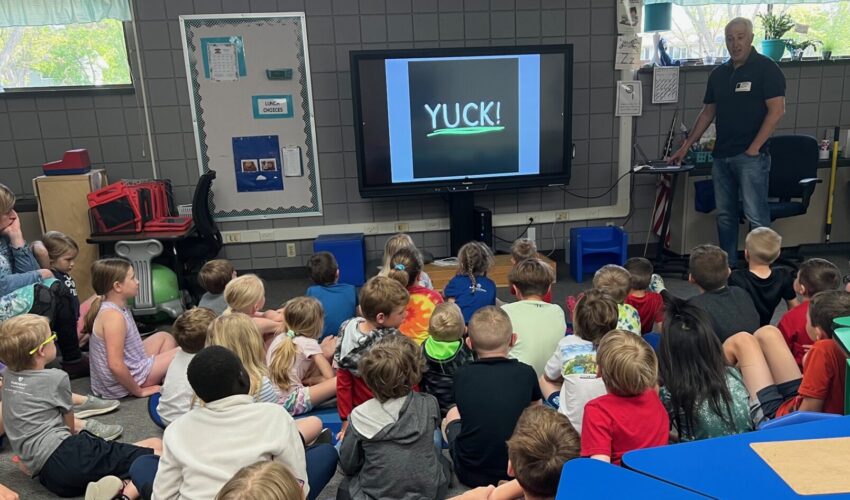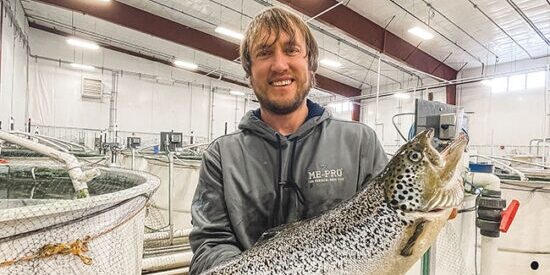Aquaculture leader honored among nation’s most promising up-and-comers
Dec. 4, 2023
This paid piece is sponsored by South Dakota Biotech.
It’s a goal any dedicated fisherman could support: helping put more fish in lakes.
For Luke Frederickson, who grew up fishing with his dad in Minnesota, a love of land and water pointed him to a career.
Frederickson grew up on a small corn and soybean farm near Hector, Minnesota, and graduated from the University of Minnesota, where he studied fisheries and wildlife management.
“I knew I wanted to work with fish,” he said. “The idea of working in a hatchery was a dream of mine probably since I was 14. I really liked the idea of helping put more fish in lakes for people to catch.”
Since then, the 37-year-old’s career has led him to a South Dakota startup, where he serves as the aquaculture research manager at Houdek, formerly Prairie AquaTech, and his work recently landed him on the Top 10 Under 40 list recognized by trade publication Hatchery International.
“Luke is an amazing example of how professionals are growing biotech careers in our state and achieving national recognition while doing so,” said Joni Ekstrum, executive director of South Dakota Biotech. “The success of Houdek, which has so much growth potential ahead, is due in large part to the ability to attract and retain talent like Luke.”
We learned more from Frederickson about his work and why a biotech career in South Dakota is such a good fit.
Beyond your early childhood interest, what made you pursue a career in your specific field?
While in college, I took a sustainable aquaculture class where I also worked in the university’s fish laboratory. It was during a field trip for this class — we toured a tilapia farm in Renville, Minnesota — that I was first introduced to the private sector of hatcheries and that people farmed fish. I was hooked literally!
Tell us about your early career experience and how that prepared you for your role at Houdek.
I worked as an intern for the Minnesota Department of Natural Resources in their pathology lab. It was here that I got to visit numerous state and private hatcheries to do fish health testing — annual screening of fish for different pathogens in order to sell/stock fish in public water.
This internship brought me to my next career path, which was working with a private fish farm, Oswald Fisheries. Oswald had farms in Minnesota and Bruce, South Dakota, a farm that produced many different species of fish, including minnows for bait to gamefish like walleyes and perch. This is what brought me to South Dakota.
I learned about the many ways fish can be raised, including recirculating aquaculture systems. I really liked how you could conserve water by using different water filters to recycle it. We raised a lot of fish, but a lot of what we did included raising fish in large ponds outdoors. It was very similar to farming, meaning we stocked small fish in late spring — the seed — and we used large nets to catch the fish in the fall — the harvest.
You joined Houdek in 2015. What about the opportunity appealed to you?
At Oswald, I worked with Scott Sindelar, who was a really good friend and “fish guy,” as I call them. He had decided to pursue a master’s degree in fisheries at SDSU under Dr. Mike Brown, who along with Dr. Bill Gibbons came up with the idea to microbially enhance soybean meal to help the fish utilize the nutrient more efficiently. Scott was doing his master’s research with Prairie AquaTech. The research that Houdek — then Prairie AquaTech — was doing to help farmers utilize more soy-based ingredients in their fish feeds was really interesting to me. And so I decided that I could almost merge my passion for raising fish with the values that I grew up with, which was farming of crops.
What does your work as an aquaculture research manager entail? What are you currently working on?
We have conducted over 100 fish or shrimp feeding trials since I have been here. There is a lot that goes into raising fish and maintaining the systems. We hatch most of our own fish, so we are continuously bringing in new eggs throughout the year. Fish are then placed throughout our facility in different systems for growth and digestibility trials. The evaluation of ingredients used in the fish feeds begins with the first feeding of baby fish, fry, all the way to looking at how different feed “recipes” can change how the fish fillet tastes.
The fish growth rates are monitored so we can determine how well each diet or recipe performs in different species. Fish are very efficient at utilizing feed; for every pound of feed they consume, they gain 1 pound of weight, meaning they have a feed conversion ratio, or FCR, of 1:1. This is better than other terrestrial animals like cows, pigs or chickens that have FCRs of 5:1, 3:1 or 2:1 respectively.
We are currently working with coho, or silver, salmon that we hatched and developing feeds that incorporate more sustainable ingredients like ME-PRO, our fermented soy protein ingredient, into their diets, which rely heavily on fish or marine ingredients that are overfished or less sustainable.
Ingredients like ME-PRO, algae oil and insects meals — black soldier fly larvae — have gotten a lot of “buzz” with the industry because feed manufacturers are putting more of a focus on carbon footprint and sustainability.
What are you most excited about in terms of Houdek’s growth potential and success so far? What kind of broader implications do you feel your work is having?
I remember when I first started we were only producing product at pilot scale. And now we have a commercial plant in Volga that is producing close to 30,000 tons of fermented soy protein that is being shipped all over the world. I love thinking about how our product is helping fish farmers raise fish in a more sustainable way — cheaper too — while helping feed the world. I love to eat fish too, and I think that our fermented soy protein makes the fish fillets taste better, though I may be a little biased.
I want to help grow the aquaculture industry, and the research we are doing is helping farmers do that. I think the U.S. can do a much better job at producing the seafood that we need. America imports 70 to 85 percent of its seafood; that’s a national seafood trade deficit of $17 billion, according to NOAA Fisheries. We can grow more domestically.
What do you like about growing your career in South Dakota? What might you tell others considering a similar path?
I love everything about South Dakota. We value our fish and wildlife. They are very important for tourism and recreation. Whether you farm crops, livestock or fish, you depend on the land, so we are incredible stewards of the land. We are always going to take care of the land and our family. God only gave us one planet, and we need to take care of it.
I have been told by so many people that I have passion and they see it on my face; my only response to that is that I love my job. I am so thankful to my wife and family for their support. I am also thankful to be part of a team at Houdek that feels so much like a family.
With new name, business rooted in aquaculture finds traction in multiple markets

